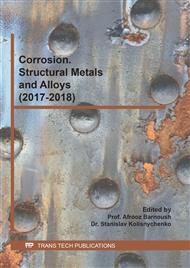p.1686
p.1692
p.1698
p.1705
p.1710
p.1716
p.1722
p.1728
p.1734
Influence of Rolling Force on Corrosion Resistance of Interstitial-Free Auto Sheet Steel
Abstract:
A three dimensional (3D) surface profiler, an X-ray residue stress tester, a potentiodynamic polarization approach and a damp heat test were employed to investigate the relationship between the rolling force (RF) and the corrosion resistance of interstitial-free (IF) auto sheet steels. The results show that the change of rolling force induces the variance of the surface topography and surface residue stress of IF steel. With the increasing RF, the corrosion resistance of IF steel in damp heat test can be enhanced, and the corresponding corrosion current density declines. Further, it is proved that the tensile stress on the surface can accelerate the corrosion rate of IF steel. As the compressive stress and the valley proportion on the surface increase, IF steel samples present a better corrosion resistance, because the compressive stress could retard the diffusion of corrosion media and the valley position possesses a lower electrochemical activity.
Info:
Periodical:
Pages:
1710-1715
Citation:
Online since:
December 2018
Authors:
Price:
Сopyright:
© 2018 Trans Tech Publications Ltd. All Rights Reserved
Share:
Citation:



